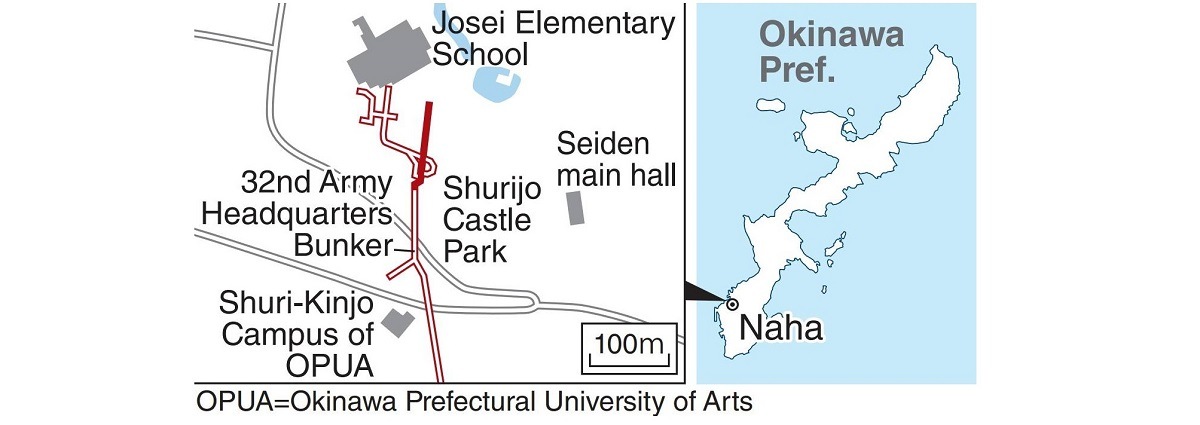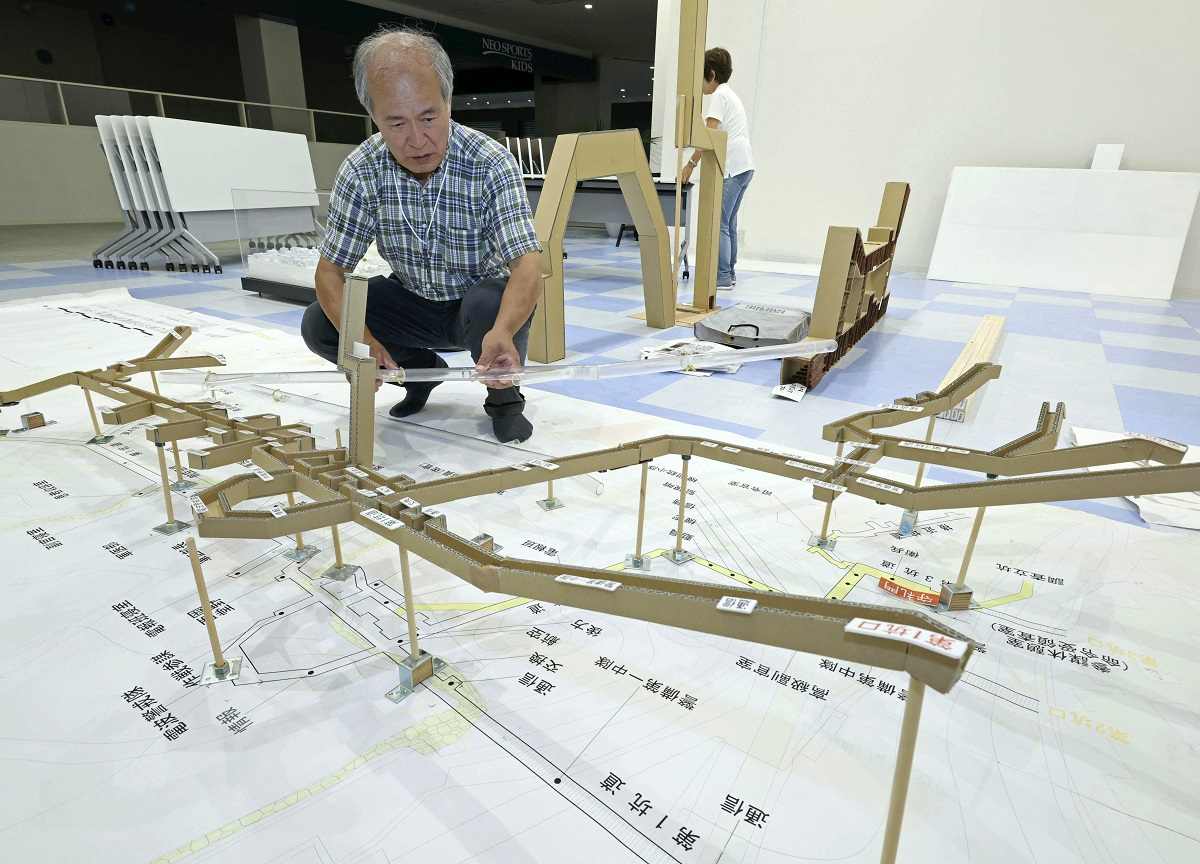
The inside of the No. 5 tunnel of the former 32nd Army Headquarters Bunker with bare rock walls is seen in 2020.
12:13 JST, July 8, 2023
NAHA — A tunnel that served as the command center of the Imperial Japanese Army in Okinawa may be opened to the public in the near future. The bunker, which was blown up by Imperial forces at the end of World War II, has been located underground around Shuri Castle in Naha.
Having mapped out the exact locations of the sprawling underground command complex, the Okinawa prefectural government intends to excavate it and open it for viewing in fiscal 2025.
The 32nd Army Headquarters Bunker is seen as a war monument symbolizing the Battle of Okinawa. It was comprised of five tunnels, which were dug like a web. The total length of the tunnels was more than 1 kilometer.
In March 1945, the command headquarters was moved inside the bunker complex, with the No. 1 tunnel accommodating its most central part.

The precise location of the No. 1 tunnel had long been unknown, although the position was roughly estimated by a U.S. military report. But in the wake of a fire that ravaged Shuri Castle in 2019, the Okinawa government began in July last year to conduct its own research about the tunnel. The research, which included exploratory borings, found soil structures around the area that helped pinpoint the location of the No. 1 tunnel, a little west from the U.S. military’s estimate.
Decision to continue battle
Many experts and other concerned people have called for the bunker to be preserved and opened to the public, since the bunker is expected to show people the reality of war. The decisions made in this bunker led to great tragedy for the Okinawan people.
U.S. forces landed on Okinawa Island in April 1945. The 32nd Imperial Japanese Army, which was in charge of defending Okinawa, holed up in trenches around Shuri Castle and carried out skirmishes against the U.S. forces.
Commanding officer Mitsuru Ushijima concluded that his army would not be able to defend against attacks there, and on May 22, he decided to retreat to the southern part of the island.
The army blew up the bunker and left Shuri after the following edict from Ushijima: “We shall continue fighting until the last soldier would remain alive and as long as we occupy an inch of land at the southernmost tip of Okinawa Island.”
It is believed that the purpose of the retreat was to delay the U.S. forces’ advance to Japan’s main islands even by a bit, and that decision cost the lives of many Okinawans.
The retreat turned the southern part of Okinawa Island into bloody, horrible battlefields, with one in four residents being killed. It is said that these victims died to defend the main islands.
Most parts of the bunker tunnels are now buried under soil, so people can enter only a limited part of them. So far, only the entrance of the No. 5 tunnel has been cleared.
The No. 1 tunnel was basically a straight shaft about 200 meters long that branched off to accommodate an operations office and a room for staff officers. Various operational decisions were made there.
It is believed that the decision to retreat to the south was made in a bedroom for staff officers inside the No. 3 tunnel, and it is uncertain whether that tunnel can be opened together with the No. 1 tunnel. Due to poor ventilation and other factors, it seems to be difficult to ensure safety inside the No. 3 tunnel.
“Finding the exact location of the command center is the first step toward opening the valuable battle site to the public,” said Shinobu Yoshihama, a former professor at Okinawa International University, who is an expert of modern Okinawa history. “The prefectural government should make progress in the accumulation of information through, for example, hearings from the survivors.”
‘Like the A-Bomb Dome’
Among those welcoming the rising momentum for research is Shunji Fukumura. The 70-year-old architect has built a scale model of the underground command bunker.

Shunji Fukumura, left, explains about the 32nd Army Headquarters Bunker using a scale model of it in Tomigusuku, Okinawa Prefecture, on June 9.
Fukumura moved to Okinawa from Shiga Prefecture. He also designed the building for the Okinawa Prefectural Peace Memorial Museum, which opened in 2000 in Itoman.
Around February 2020, he was asked to make a scale model of the bunker for the purpose of preserving and eventually opening the bunker to the public. He immersed himself in a thorough examination of the structure and its history. He also used the U.S. military’s report as a reference because they had checked the interior of the bunker just after the Japanese army retreated from it.
Fukumura learned that the five tunnels of the bunker not only housed the operations office and the room for staff officers, but also bedrooms, a kitchen and a hospital facility. He reproduced these structures with polystyrene foam.
The scale model was displayed in the city hall of Okinawa City, central Okinawa Island, and other places, and he saw firsthand the reactions of local citizens. However, Fukumura said he feels that there is a limit to the impact of only a scale model.
“Seeing the real thing, like visiting the Atomic Bomb Dome, can convey a much more vivid message,” said Fukumura.
“I hope the site will help people understand the historical facts without turning their eyes away from the negative legacy of the war with the importance of peace inherited.”
Related Tags
"Features" POPULAR ARTICLE
-

Sanrio to Open Museum in Yamanashi Pref. Dedicated to Founder, Exhibits Include Hello Kitty, Other Characters
-

Autumn Foliage Surrounds Visitors to Tokyo’s Showa Kinen Park
-

My Daughter No Longer Speaks to Me, But I Want to See Her and My Grandchild
-

Kumamoto: Public Bath Refurbished as Library Where You Can Chat, Take Photos
-

Frozen Vegetables: Demand Rises for Convenient, Tasty Domestic Produce
JN ACCESS RANKING
-

Tokyo Economic Security Forum to Hold Inaugural Meeting Amid Tense Global Environment
-

Keidanren Chairman Yoshinobu Tsutsui Visits Kashiwazaki-Kariwa Nuclear Power Plant; Inspects New Emergency Safety System
-

Imports of Rare Earths from China Facing Delays, May Be Caused by Deterioration of Japan-China Relations
-

University of Tokyo Professor Discusses Japanese Economic Security in Interview Ahead of Forum
-

Japan Pulls out of Vietnam Nuclear Project, Complicating Hanoi’s Power Plans

























